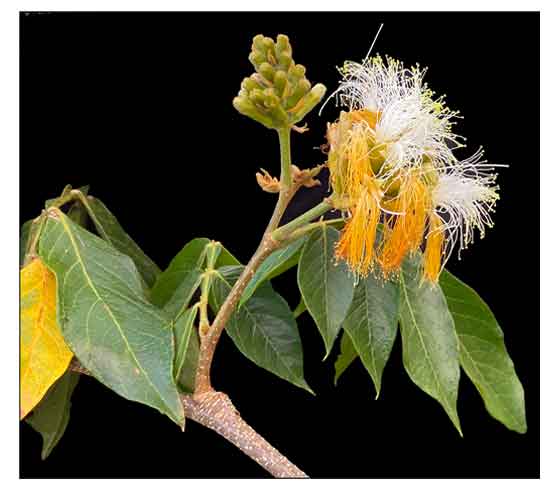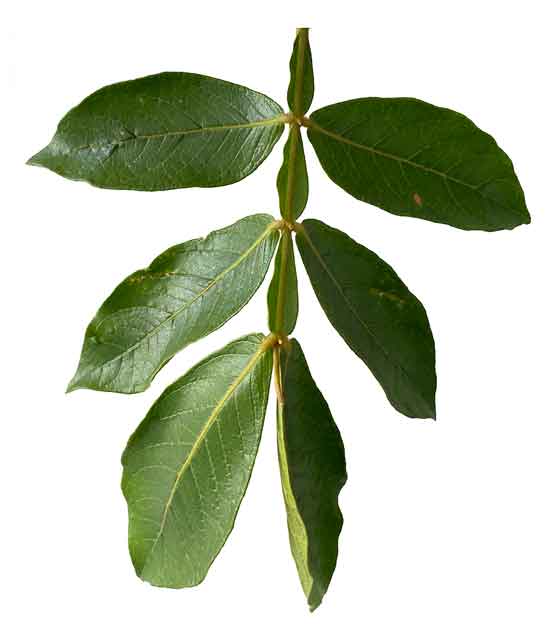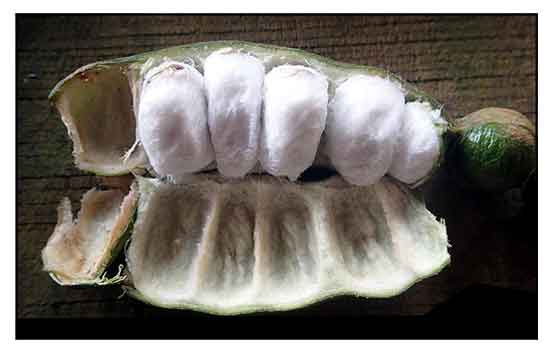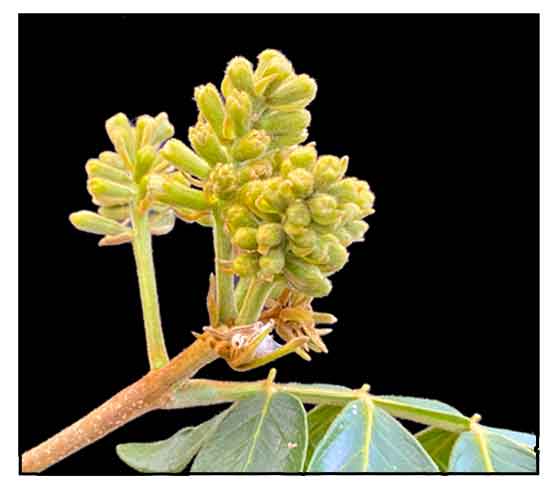 Gen info Gen info
- Inga is a genus of small tropical, tough-leaved, nitrogen-fixing trees and shrubs of about 300 species, most if them native in the Amazon forest regions. Trees are usually found by river and lake edges, with seeds carried there by floods.
(2)
- Etymology: The genus name derives from the name of the Tupi people of South America, ingá. An alternative is that in-ga is a Tupi word meaning "soaked" referring to the fruits fruit powder consistency. The species epithet edulis derives from Latin, meaning "edible". The common name "ice cream bean" allude to the sweet flavor and smooth texture of the pulp. (2)
- Joaquiniquil and cuaniquil names are both fro Nahuatl: cuahuxinicuile combining cuahuitl "tree", icxitl "feet", and necuilli "crooked". (2)
- Inga species are in symbiosis with ants (Pheidoles spp.) who feed on the nectar of the extrafloral nectaries. In exchange, they protect the plant against herbivores.
(2)
 Botany Botany
• An evergreen tree in tropical regions or deciduous tree in colder regions. It reaches a height of 30 m (98 ft) and 60 cm (2.0 ft) diameter at breast height, usually branching from below 3 m (9.8 ft). Branches form a broad, flat, moderately dense canopy. Trunk is pale gray. Stems and young twigs can be sparsely to densely haired. Leaves are alternate, evenly pinnate, 10–30 cm long with 4–6 pairs of opposite, dark-green, membranous, slightly pubescent, oval leaflets. Terminal leaflets can grow up to 18 cm long by 11 cm wide in comparison to the basal ones. Extrafloral nectaries on petioles and stipules are inconspicuous, absent, or caducus. Flowers are fragrant, sessile, pentamerous, are arranged in dense axillary spikes. Flower has a calyx tube with five puberulent, striate lobes, corolla with five silky, villous petals, 14–20 mm long and contain numerous white stamens. Fruits are longitudinally ribbed, cylindrical indehiscent leguminous pods which can be straight, curved or often spirally twisted up. They are pendant and up to 1 m long and yellowish brown to greenly colored. Ovoid seeds can vary from 10 to 20, purplish-black to olive colored, embedded in the sweet, cottony, white arillus. (2)
Distribution
- Naturalized.
- Native to Argentina Northwest, Bolivia, Brazil North, Brazil Northeast, Brazil South, Brazil Southeast, Brazil West-Central, Colombia, Ecuador, French Guiana, Galápagos, Guyana, Peru, Suriname, Venezuela. (1)
 Constituents Constituents
- Nutritional analysis of pulp per 100 g (3.5 ox) yielded: Energy 251 kJ (60 kcal), carbohydrates 15.5 g, dietary fiber 1.2 g; fat 0.1 g; protein 1.0 g. Seeds per 100 g (3.5 oz) yield: Energy 494 kJ (118 kcal), carbohydrates 24.0 g, dietary fiber 1.6 g, fat 0.7 g, protein 10.7 g. (2)
- Dereplication strategy using HPLC-SPE-TT, RP-HPLC-PDA and NMR spectroscopy identified sixteen compounds from the leaves extract, including four tritrpenes (lupeol, α-amirin, olean-18-ene acid and frideline), three flavonoids, eight phenolic acids, an anthocyanin derived from delphinidin-3-glycoside and a mixture of five acylated anthocyanins. (see study below) (4)
- Study of fractionated methanol-water extract of leaves to identify polyphenolic compounds yielded gallic acid, catechin, epicatechin, myricetin-3-rhamnopyranoside, quercetin-3-glucopyranoside and quercetin-3-rhamnopyranoside. (see study below) (7)
- Chromatographic analysis of seeds yielded one anthocyanin from an aqueous fraction and a mixture of three anthocyanins from methanolic fraction. (see study below) (8)
- Bioassay-guided fractionation of seed extract afforded 3 saponins: concinnoside D (1), julibroside A1 (2), and julibroside A3 (3). (see study below) (9)
- A partial purification of I. edulis leaf extract and fraction using UPLC-DAD-MS/MS yielded main components of epicatechin, apigenin C-do-hexoside, myricetin-O-hexose-deoxyhexose, myricetin-O-deoxyhexose, and vicenin-2. (see study below) (15)
Properties
- Studies have suggested antiviral, antioxidant, photo/chemopreventive, anti-multiple myeloma, anti-Candida, antitumor properties.
Parts used
Leaves, bark, roots, seeds.
 Uses Uses
Edibility
- Fruits are edible, sweet-flavored and smooth-textured, reminiscent of vanilla ice cream. Some varieties impart a sight cinnamon flavor. (2)
- Large green or black seeds iare edible only when cooked and impart a taste akin to chickpeas. Toxic compounds such as trypsin and chymotrypsin inhibitors in the seeds are destroyed by cooking.
(2)
- In Columbia, arils are used to prepared an alcoholic beverage called cachiri for a festival of the same name. Native women chew the arils, which as spit in a vat and left to ferment. (2)
Folkloric
- No reported folkloric medicinal use in the Philippines.
-
In South American folk medicine, decoction of leaves, bark, or roots used for treatment of diarrhea, arthritis, and rheumatism. Crushed and boiled leaves eaten to relieve coughing; also applied to herpetic lip sores. (2)
- Seeds are used as natural purgative for human and cattle.
• Others :
- Agroforestry: Widely cultivated in agroforestry systems with its rapid growth and improvement of soil properties through nitrogen fixation. Alley cropping is used to restore soil fertility, an alternative to slash and burn cultivation. Also used as shade tree for coffee, cocoa, and tea plantations. (2) It has tolerance of acid soils and high production of leafy biomass to control weeds and erosion. (11)
- Wood: Timber used as lumber in construction and furniture making.
- Fuel: As firewood, it has high calorific value with weak smoke production.(2)
- Fodder: Cuttings and leaves used as mulch and animal fodder. (2) Fruits of low quality are consumed by livestock, pigs, poultry or fishes.
 Studies Studies
• Antioxidant / Leaves: HPLC-SPE-TT, RP-HPLC-PDA and NMR spectroscopy identified sixteen compounds from the leaves extract, including four tritrpenes, three flavonoids, eight phenolic acids, an anthocyanin derived from delphinidin-3-glycoside and a mixture of five acylated anthocyanins. The metabolic profile of the species indicated the presence of phenolic compounds as major constituents justifying its strong antioxidant potential performed in ß-carotene test. (see constituents above) (4) In a study of four plants used in Amazonian folk medicine with high antioxidant activity, the methanolic extract of leaves showed average amounts of polyphenols but ranked first in the majority of tests, indicating presence of efficient compounds with important antioxidant properties. (14)
• Antiviral in WNV-Infected Neuroblastoma Cells / Leaves: Study evaluated the antiviral effect of leaves extract at different stages of West Nile Virus (WNV) infection of neuroblastoma cells. The main compounds did not retain the blood-brain-barrier permeability. CC50 was 144.6 µg/mL, with highest concentrations used (25 and 50 µg/mL) not significantly cytotoxic to cells. The 25 µg/ml concentration showed anti-WNV action added before or during the infection procedure. Results suggest the crude extract compounds from leaves have inhibitory activity in WNV infection in neuroblastoma cells and has potential for further exploration as antiviral drug. (5)
• Photochemoprevention / UV Radiation / Leaves: Study evaluated a topical formulation containing purified fraction of I. edulis extract and evaluated the skin penetration of the compounds. The photoprotective/phtochemopreventive potential of the formulation containing the purified fraction were investigated in vitro and in vivo. The 1% topical formulation increased endogenous antioxidant potential of the skin, and vicenin-2 and myricetin compounds were able to penetrated epidermis and dermis. The purified fractions (25 anmd 50 mg/mL) showed protective effect against UVA and UVB radiation in L929 fibroblast cells. In vivo studies showed an anti-inflammatory effect on skin of animals after UVB exposure, with reduction in MPO activity, IL-1ß and TNF-α cytokines, and CXCL1/KC chemokine concentrations. Results suggest the phenolic-rich topical formulation of the purified fraction has potential as alternative to prevent skin damages induced by UV radiation via antioxidant and anti-inflammatory properties. (6)
• Antioxidant Flavonoids / Leaves: Study of fractionated methanol-water extract of leaves to identify polyphenolic compounds yielded gallic acid, catechin, epicatechin, myricetin-3-rhamnopyranoside, quercetin-3-glucopyranoside and quercetin-3-rhamnopyranoside. The drug crude extract exhibited very high values of ORAC (11.16 mmol TE per g) and total phenolic (496.5 GAE/g). Identified compounds were responsible for 9.53% and 12.10% of ORAC value and TP content, respectively. (7)
• Anthocyanins / Antioxidant / Solar Protection Factor / Seeds: Chromatographic analysis of seeds yielded one anthocyanin from an aqueous fraction and a mixture of three anthocyanins from methanolic fraction. The anthocyanin and derivatized compounds showed high antioxidant potential and an SPF (solar protection factor) lower than six, which is lower than the minimum accepted by current Brazilian legislation. None of the compounds showed significant cytotoxic activity against the tumor cell lines studied. (8)
• Effect on Multiple Myeloma Cells / Seeds: Multiple myeloma is an incurable hematologic cancer with an average survival of 5 to 10 years. Study evaluated the in vitro inhibitory activity of inga edulis seed extract and isolated compounds against multiple myeloma cells. Bioassay-guided fractionation afforded 3 saponins: concinnoside D (1), julibroside A1 (2), and julibroside A3 (3). Compounds 2 and 3 exhibited antiproliferative activity with IC50s in low µM range. Results suggest a potential source of compounds against multiple myeloma. (9)
• IETI / Anti-Candida / Seeds: Study characterized IETI, the first trypsin-inhibitor purified from Inga edulis. Amino-terminal sequencing revealed the IETI shows homology with the Kunitz family. IETI exhibited activity against Candida ssp., including C. buinensis and C. tropicalis. The inhibitory activity triggered yeast membrane permeability, affecting cell viability. Results suggest use of IETI for further studies for control of fungal infections. (10)
• Biomass Growth: Study evaluated the above ground biomass growth of I. edulis, its correlation with other growth parameters. Trunk diameter showed to be a more useful indicator of growth and biomass production than height. I. egulis produces high quality biomass, especially fresh leaves, with high N content. (11)
• Antitumor Potential / Fruit Peel: Study evaluated the metabolic profiling of Inga species with antitumor potential. The I. edulis fruit peel (IC50 18.6 µg/mL) and I. laurina seed (IC50 15.2 µg/mL) showed cytotoxic activity against cell line T98G. The chemical composition of the species showed a wide variety of aromatic acids, flavonoids, tannins, and carotenoids. The high concentration of polyphenols (5% to 30%) may be responsible for the antitumor potential. (13)
• Photochemopreventive / Potential for Topical Formulation / Leaves: A partial purification of I. edulis leaf extract and fraction using UPLC-DAD-MS/MS yielded main components of epicatechin, apigenin C-do-hexoside, myricetin-O-hexose-deoxyhexose, myricetin-O-deoxyhexose, and vicenin-2. Both extract and fraction showed high antioxidant capacity, with the fraction exhibiting higher polyphenol and flavonoid contents and higher content of vicenin-2. Cytotoxicity and photostability were assessed in L929 fibroblast cells and were found suitable for topical application. UVA and UVB irradiation of the extract and fraction did not decrease the antioxidant capacity and cell viability of L929 fibroblasts, suggesting photostability. Results suggest both extract and fraction have potential for incorporation into topical photochemopreventive formulations. (15)
Availability
Wild-crafted.
|

![]()



 Gen info
Gen info Botany
Botany
 Uses
Uses Studies
Studies 